MH SET Paper 1 Mock Test - 3 - MAHA TET MCQ
30 Questions MCQ Test MH SET Mock Test Series 2025 - MH SET Paper 1 Mock Test - 3
Direction: Study the following line graphs and answer the given questions.
The graph shows the ratio of marks of History to Geography of 7 students in an examination.
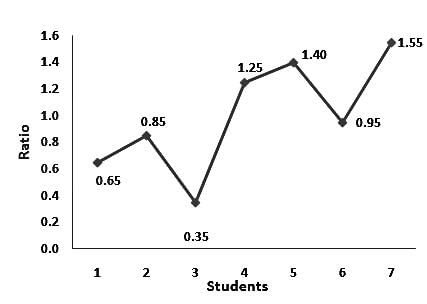
Q. How many students got more marks in History than in Geography?
The graph shows the ratio of marks of History to Geography of 7 students in an examination.

Q. How many students got more marks in History than in Geography?
Direction: Study the following table chart carefully and answer the question given beside.
The following table represents the Maximum marks of five subjects and marks obtained by five students in five subjects.
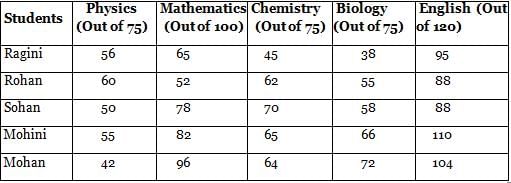
Q. Marks obtained by Ragini in Chemistry and Biology together is what percent of the marks obtained by Mohini in Physics and Mathematics together?
Which of the following learner characteristics are likely to influence the effectiveness of teaching aids and evaluation systems to ensure positive results?
(A) Learner’s family background, age and habitation
(B) Learner’s parentage, socio-economic background and performance in learning of the concerned subject
(C) Learner’s stage of development, social background and personal interests
(D) Learner’s maturity level, academic performance level and motivational dispositions
Directions: Answer the given question based on the following table.
Marks obtained by 6 candidates A, B, C, D, E and F:
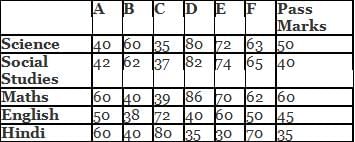
Q. The marks obtained by C in English were what percentage more than those obtained by F in Maths?
The essence of effective communication is mentioned in which of the following statements?
Directions: Read the below information carefully and answer the question that follow.
The bar graph shows revenue (in lakhs) of a food company that sells different kinds of food items:

Q. What is the growth in total revenue from 2004 to 2006?
Match List I with List II
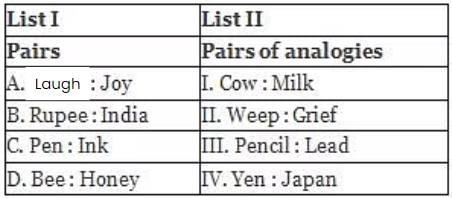
Choose the correct answer from the options given below:
Which of the following is not a matter of global concern in the removal of tropical forests?
Which of the following is not a type of Research Method?
The following tables shows marks obtained out of 100 by Sunita and Jessica in five subjects:

Based on the table above identify the correct statement from the following:
Direction: The given table represents the number of employees recruited by four companies A, B, C and D in the five years. Study the table carefully and answer the following questions.
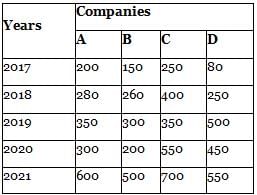
Q. Find the average number of employees recruited by company C and D together for all five years:
Match List – I with List – II and find the correct answer from the codes given below:

Directions: Study the given table and answer the following question.
The following table shows the number of students of 7 colleges participating in extra curricular activities:
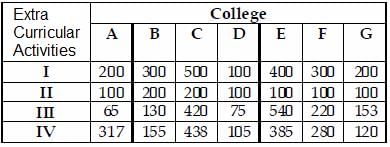
Q. Percentage of the number of students in activity II to that of IV is
Select the option that is related to the third word in the same way as the second word is related to the first word.
Biology : Science : : Political Science : ?
Direction: Read the given passage and answer the questions that follow.
Early feminist theory had emphasised the commonalities of women's oppression, neglecting profound differences between women in terms of class, age, religion, race and nation. As its exclusionary nature became evident, the collective 'we' of feminism was called into question. The inadequacies of feminist theorising that conflated the condition of white, middle class women with the condition of all women were highlighted in North America by black and Latin feminists, and in Britain by black and Asian feminists. Such critiques evoked the concepts of 'inter‐locking identities' and inter‐locking oppressions'. Related and more radical analyses came from feminist scholars in the Third world, where quite different agendas were called for. These critiques heightened the irrelevance of western feminism's analytical frameworks to the lives of most women around the world and attempted to reposition feminist debate within broader social, economic and cultural contexts of analysis advocated by scholars such as Janus. Such critiques spoke from a post‐colonial position, in which the self‐assumed authority of western feminists to speak about or indeed for others was disputed and decentered. Influential accounts of the tendencies of masculinist imperialist ideological formation to construct a 'monolithic Third world' woman', discursively constituted as the universal victim of Third world patriarchy, challenged feminists to "unlearn" their privilege and to deconstruct their own authority as intellectuals. These positions appeared to question the legitimacy of outside intervention of any kind, whether intellectual or political. Although subsequently attempted by the Third world scholars anxious to move beyond standpoints that threatened to mark all feminist politics as either inauthentic or unnecessary, they were enduringly influential in highlighting the questions identity and authority in feminist studies.
Q. The analytical frameworks of western feminists were critiqued by Third world scholars as:
Directions: Read the following passage carefully and answer the question.
I had occasion to work with her closely during the Women's International Year in 1975 when she was chairing a Steering Committee and made me the member in charge of publicity. Representatives from different political parties and women's organisations were on the committee, and though the leftists claimed a sort of proprietary right over her, Aruna encouraged and treated all members alike. It was not her political affiliations or her involvement in a particular cause, which won her respect and recognition, but her utter honesty in public life, her integrity and her compassion for the oppressed which made her an adorable person. She had the courage to differ with and defy the mightiest in the land; yet her human spirit prompted her to work in the worst of slums to offer succour to the poor and the exploited.
In later years – around late eighties and early nineties – Aruna Asaf Ali's health began to deteriorate. Though her mind remained alert, she could not actively take up her pet causes – action for women's advancement, planning for economic justice, role of media, reaffirmation of values in public affairs etc. Slowly, her movements were restricted and Aruna, who had drawn sustenance from common people, from her involvement in public life, became a lonely person. She passed away in July 1996.
Q. Who were made the members of the Committee of Publicity?
(i) Representatives from different political parties
(ii) Representatives from the leftist parties
(iii) Representatives from the women's organisations
(iv) None of the above
Directions: Answer the given question based on the following data.
Total number of students in the university = 2160
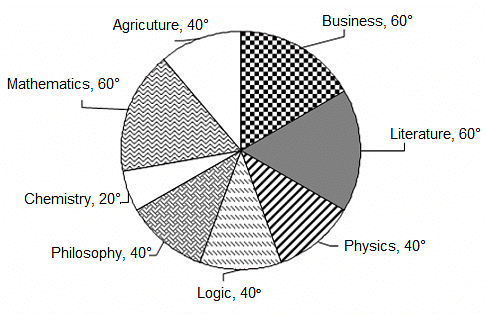
Q. On a particular day, if the students of Mathematics, Physics and Chemistry go on a strike and all the students of other disciplines attend the classes, find the ratio of the total number of Agriculture students to the total number of students who attend the classes.
Which of the following areas of liberal education at the higher level in the feudal society of Europe were classified under quadrivium?
A. Grammar
B. Logic
C. Arithmetic
D. Astronomy
E. Music
Choose the correct answer from the given options.
Direction: Read the passage carefully and answer the following question.
If the world is different today, we need to think, talk and engage accordingly. Falling back is unlikely to help, he said adding “purposeful pursuit of national interest is shifting global dynamics”. Highlighting India’s new approach in dealing with terrorism he compared “lack of response to the terror attack in Mumbai in comparison to the way the country responded to the Uri and Pulwama strikes. On India walking away from the Regional Comprehensive Economic Partnership, the external affair minister said no agreement was better than having a bad agreement.
Giving a historical perspective to geopolitical issues, Jai-Shankar said “For years India’s position on the world state seemed assured but the 1962 conflict with China significantly damaged India’s standing.
Q. Year's back conflict of India with China was:
Direction: Study the following table and answer the question asked.
The data of total number of people in different cities of a country and percentage of females is given in the table.

Q. What is the respective ratio of the number of females in City C to the number of females in City E?
Which of the following statements about UPSC is not true?
|
60 tests
|



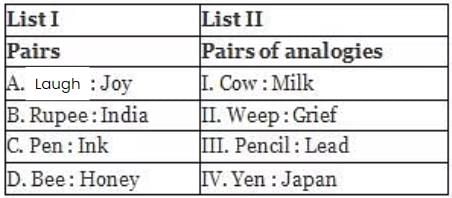




 720
720 240
240










